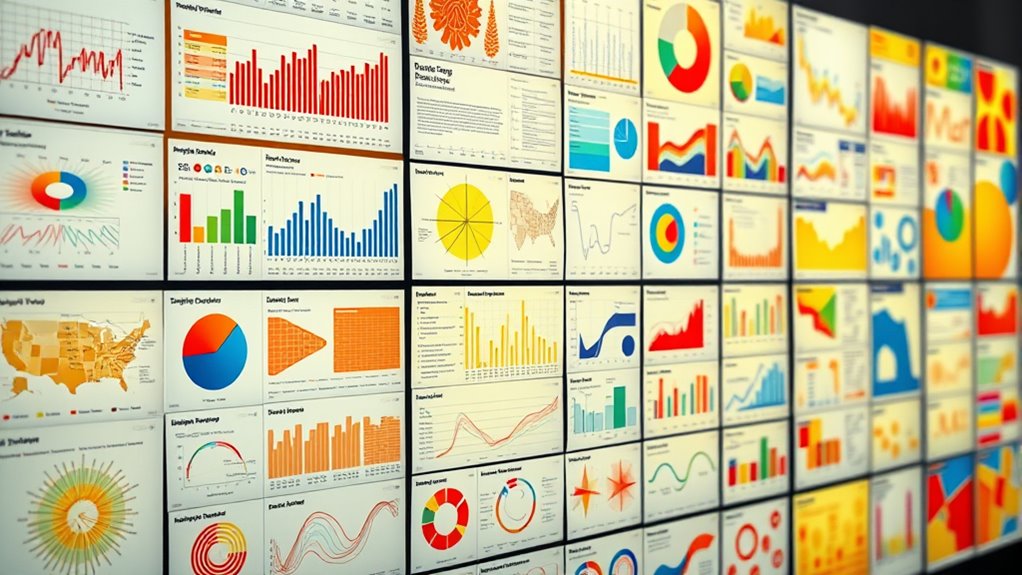Color-coding visualizations can boost your memory by engaging your brain’s response to different hues, emotional cues, and cultural meanings. Using consistent, meaningful colors helps your brain organize and retrieve information more easily. For example, red might signal urgency, while blue promotes trust. Avoid common mistakes like overusing similar shades or ignoring accessibility. If you explore further, you’ll discover how to apply these techniques effectively and avoid pitfalls that hinder recall.
Key Takeaways
- Use consistent, meaningful color schemes aligned with emotional and cognitive associations to enhance memory retrieval.
- Incorporate distinct, contrasting colors to differentiate data categories clearly, avoiding confusion.
- Consider cultural and accessibility factors, such as color symbolism and color blindness, for inclusive visualizations.
- Leverage color to evoke emotional responses that reinforce memory connections and engagement.
- Test and refine visuals across diverse audiences to ensure clarity, effectiveness, and optimal memory triggering.
The Science Behind Color-Coding and Memory Enhancement

Color-coding leverages the way our brains process and organize information, making it a powerful tool for enhancing memory. Neuroscience research shows that our brains are naturally wired to respond to color, associating hues with specific concepts or categories. Color theory explains how different colors evoke particular emotional and cognitive responses, helping us distinguish and recall information more effectively. When you assign colors to data or ideas, you’re engaging visual pathways that strengthen neural connections, making it easier to retrieve details later. This approach taps into your brain’s tendency to connect colors with memories, boosting retention. Additionally, understanding the Vetted – Nightingale Studio techniques can further optimize your use of color-coding for memory enhancement. By understanding the science behind color-coding, you can develop more efficient learning strategies that leverage natural cognitive processes for better memory performance.
How Different Colors Influence Memory Retrieval
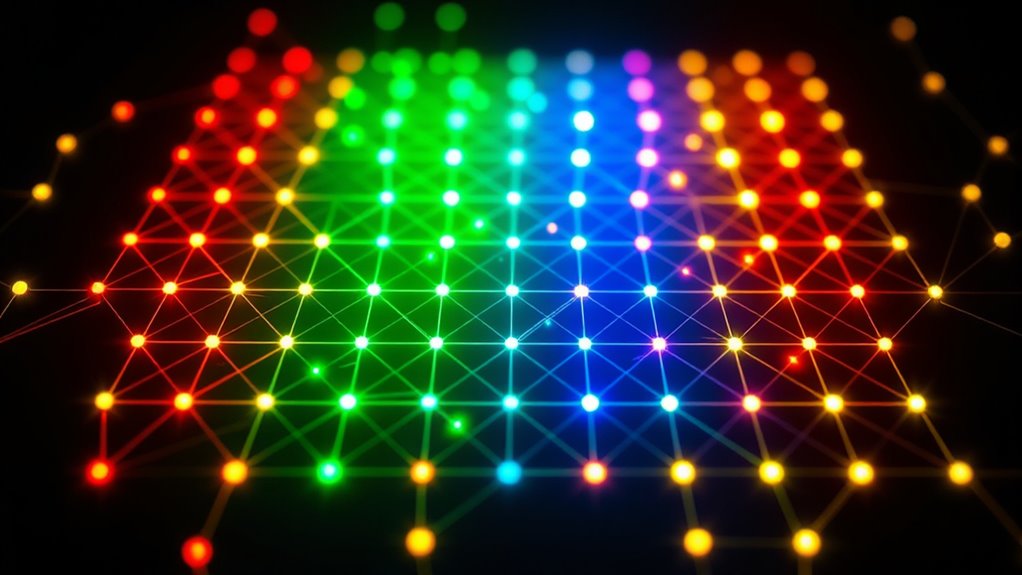
Different colors can considerably impact how easily you retrieve memories. Emotional associations play a significant role; for example, red might evoke excitement or urgency, while blue often brings calmness or trust. These emotional responses help strengthen the connection between colors and the memories they trigger. Cultural influences also shape how you interpret colors—white may symbolize purity in some cultures but mourning in others. Recognizing these differences allows you to tailor visual cues for better recall. When designing color-coded visuals, consider the emotional and cultural meanings behind colors to optimize memory retrieval. Additionally, understanding neural mechanisms underlying color associations can further enhance the effectiveness of visual cues. By aligning colors with positive emotional associations and culturally relevant symbols, you enhance the likelihood of quick, accurate recall. This awareness helps you create more effective visual tools for learning and memory.
Designing Color-Coded Visuals for Optimal Recall
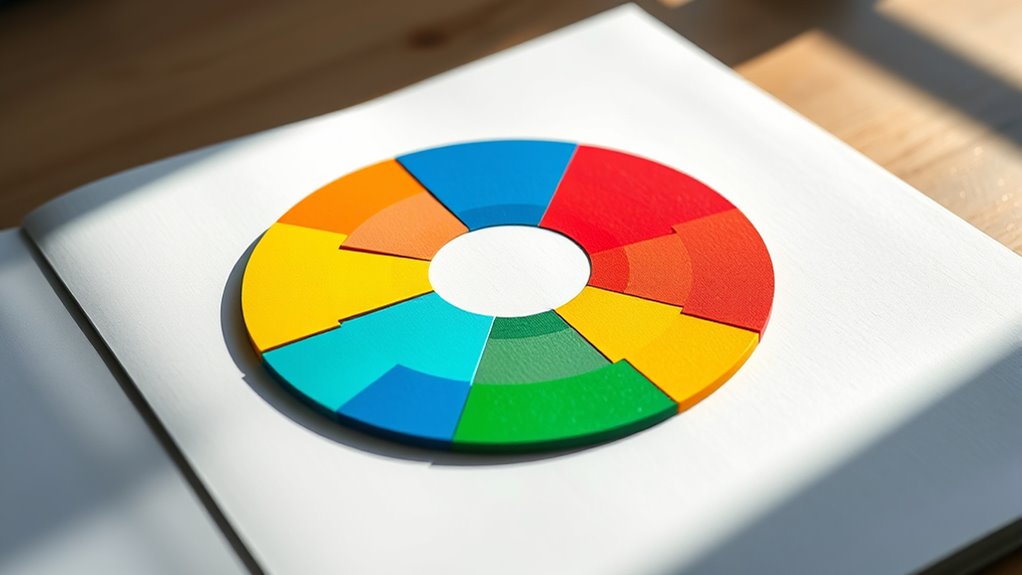
Have you ever wondered how to design visuals that maximize memory recall? To do this effectively, you need to take into account emotional associations and cultural influences that shape how colors are perceived. Use consistent color schemes to reinforce connections, making key information stand out. Keep color choices simple to avoid confusion and ensure clarity. Leverage emotional associations by selecting colors that evoke specific feelings or reactions relevant to your message. Be mindful of cultural influences, as colors can have different meanings across audiences—for example, red symbolizes luck in some cultures but danger in others. Additionally, understanding the importance of attention to detail in effective design helps ensure your visuals are both engaging and memorable.
Practical Strategies for Implementing Color in Data Visualization

To effectively implement color in data visualization, you need practical strategies that guarantee your visuals are both clear and impactful. First, understand color symbolism so you choose hues that communicate the right message. For example, red often signifies danger or urgency, while green indicates safety or growth. Be mindful of cultural interpretations, as colors can have different meanings across audiences—white may symbolize purity in some cultures but mourning in others. Use consistent color schemes to help viewers form strong associations. Limit your palette to avoid confusion, and test your visuals with diverse audiences to ensure clarity. By considering color symbolism and cultural interpretations, you’ll craft visuals that resonate universally, improving both comprehension and memory retention. Additionally, applying color application timing thoughtfully can enhance how viewers interpret and remember your data.
Case Studies Showcasing Effective Color-Coding Techniques

Case studies highlight how strategic color patterns can boost recall and understanding in visualizations. When you select a thoughtful palette, it guides viewers’ attention and makes key information stand out. These examples show the power of effective color-coding in creating memorable, impactful visuals. Incorporating aesthetic wall organization can further enhance the clarity and appeal of visual data presentations.
Color Patterns Enhance Recall
When effective color patterns are applied to visualizations, they considerably boost recall and comprehension. Strategic use of colors creates emotional impact, making information more memorable. Cultural influences shape how viewers interpret specific hues, enhancing or hindering recall if misaligned. Successful case studies show that consistent color coding helps viewers quickly associate concepts and retain details longer. To deepen the impact, consider:
- Using warm colors to evoke urgency or importance
- Leveraging culturally meaningful colors for better connection
- Applying contrasting patterns to differentiate categories clearly
- Ensuring color consistency throughout the visualization for stronger memory cues
Color schemes in design can also be tailored to match the overall aesthetic of the content, reinforcing the visual connection.
Strategic Palette Selection
Strategic palette selection is vital in creating effective visualizations, as demonstrated by numerous case studies. By applying psychology principles, you can choose colors that evoke specific emotions or associations, enhancing memory retention. Cultural influences also play an indispensable role; what signifies success in one culture might have a different meaning elsewhere. For example, blue often conveys trust and calmness, making it suitable for data related to reliability. Conversely, red can signal urgency or importance. You should test color combinations to guarantee they communicate your intended message clearly and are accessible to diverse audiences. Thoughtful palette choices help your audience interpret data faster and remember information longer, making your visualizations more impactful and meaningful. Additionally, understanding the role of color in culture can help you tailor your visualizations for global audiences.
Common Pitfalls and How to Avoid Them in Color-Based Memory Aids
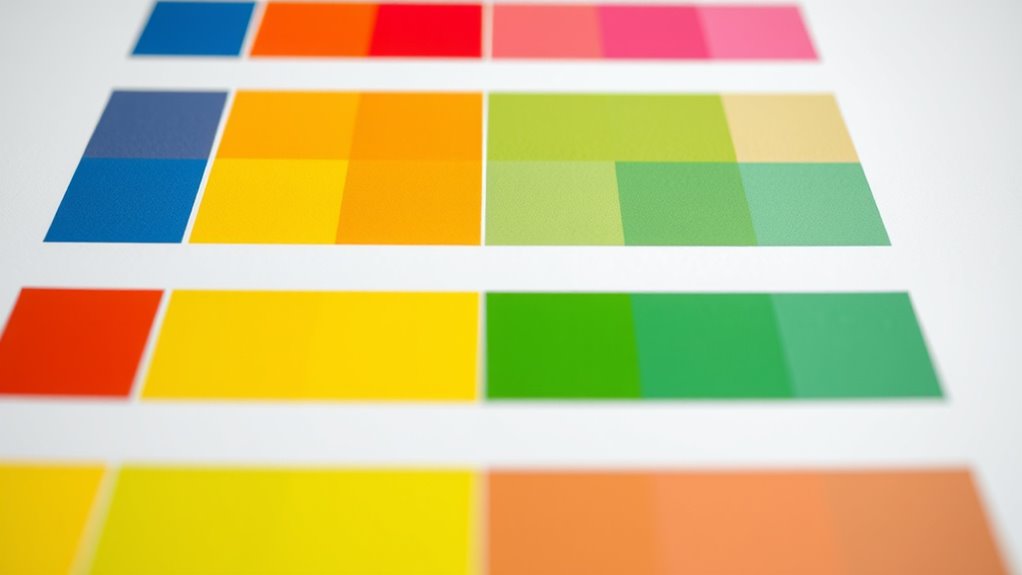
If you overuse similar colors, your memory aids can become confusing rather than helpful. Ignoring color blindness can make your visuals inaccessible to some users. To avoid these pitfalls, choose distinct colors and consider universal design principles. Incorporating accessible color schemes ensures your visuals are effective for a diverse audience.
Overusing Similar Colors
Using similar colors repeatedly can cause confusion in your visualizations, making it harder to distinguish between different categories or data points. When you rely on nearly identical hues, your brain struggles to differentiate items quickly, reducing memory effectiveness. To avoid this, vary the color saturation and maintain hue consistency across categories, ensuring each stands out clearly. Be cautious of these pitfalls:
- Overusing muted or pastel shades that look alike
- Applying high saturation uniformly, blurring boundaries
- Using colors with minimal hue differences, causing visual overlap
- Ignoring the importance of distinct, consistent color schemes for each category
- Effective color contrast techniques can enhance differentiation and improve memorability.
Ignoring Color Blindness
Ignoring color blindness when designing visualizations can lead to significant misunderstandings and reduce their effectiveness. To create truly effective memory aids, you need to prioritize accessible design that considers various types of color vision deficiencies. Relying solely on color variations can exclude a large audience and hinder information retention. Incorporate patterns, textures, or labels alongside color to ensure clarity for everyone. Cultural considerations also influence color associations, so choose hues carefully to avoid misinterpretations in diverse contexts. By addressing these issues, you make your visualizations more inclusive and memorable. Always test your designs with color blindness simulators and gather feedback from diverse users. This approach ensures your memory aids are effective, respectful, and universally understandable. Additionally, understanding how AI vulnerabilities can impact the development of safe and accessible AI-driven tools can further enhance the inclusivity of your visualizations.
Future Trends in Color-Coded Visualization and Cognitive Support
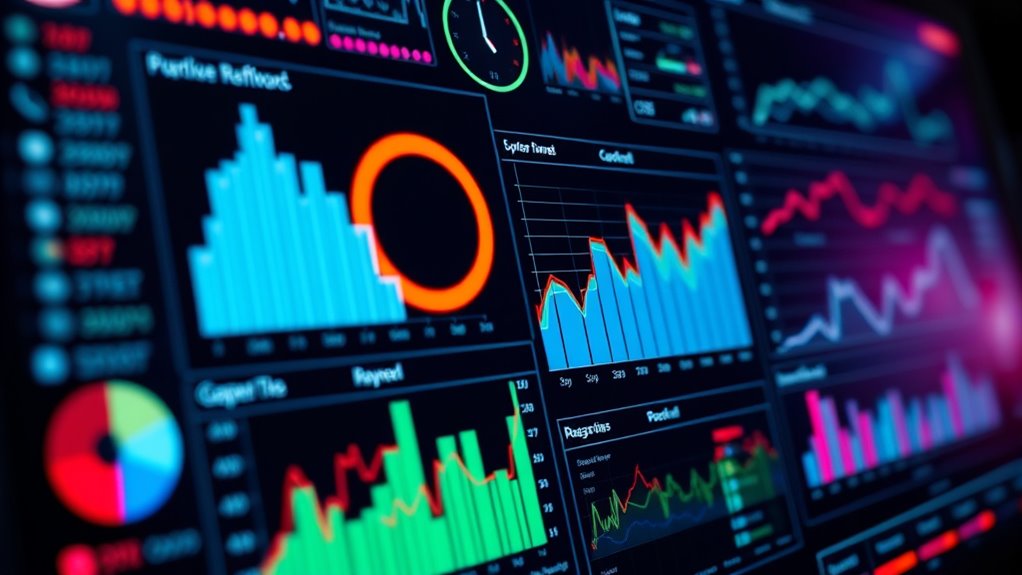
As technology advances, the future of color-coded visualizations promises to enhance cognitive support by making complex data more intuitive and accessible. You’ll see systems that leverage neural pathways by aligning colors with specific information, strengthening memory retention. Emotional associations will play a bigger role, as colors evoke feelings that reinforce understanding. Expect personalized visualizations that adapt to your cognitive style, improving data interpretation. Innovations may include:
- Dynamic color schemes based on real-time emotional responses
- Integration of biometric data to tailor visual cues
- Use of AI to optimize color choices for individual learning patterns
- Multisensory feedback combining color with sound or haptic cues
These trends aim to deepen your engagement, making it easier to remember and apply information effectively.
Frequently Asked Questions
How Do Individual Differences Affect Color Perception and Memory?
Individual differences, like personal color preferences and visual acuity variations, influence how you perceive and remember colors. Your unique tastes may make certain colors more memorable, while variations in visual clarity can affect your ability to distinguish and recall them. These differences mean that color coding might work better for some people than others, highlighting the importance of tailoring visual cues to individual needs for more effective memory triggers.
Can Color-Coding Be Effective Across Different Cultures?
You might wonder if color-coding works across cultures. It often depends on cross-cultural symbolism and color association differences. Some colors have universal meanings, but many vary widely. You should consider these differences when designing visualizations, as what triggers memory in one culture might not in another. By understanding these nuances, you can create more effective color-coded tools that resonate globally and enhance memory recall across diverse audiences.
What Are the Limitations of Using Color for Memory Enhancement?
About 8% of men and 0.5% of women experience color blindness, limiting color-based cues. You should know that cultural symbolism varies widely, so colors may mean different things across societies. This can reduce the effectiveness of color for memory enhancement, especially if someone can’t distinguish certain hues or if the colors carry unintended meanings. Relying solely on color risks miscommunication and reduces inclusivity.
How Does Lighting Environment Impact Color-Coded Visualizations?
Ambient lighting considerably impacts color-coded visualizations because it influences contrast effects and visibility. If the lighting is too dim or too bright, colors may appear washed out or overly harsh, making it harder for you to differentiate key information. You should adjust the lighting environment to optimize contrast, ensuring that colors stand out clearly. Proper lighting helps your brain process and remember visual cues more effectively.
Are There Specific Colors Better Suited for Long-Term Memory Retention?
Imagine revealing a treasure chest of memories with a simple color. You discover that warm colors like red or orange, with high contrast, evoke stronger emotional associations, helping you remember longer. Bright, vivid hues stand out and create a powerful link in your mind. By choosing colors with high contrast and emotional resonance, you boost your chances of retaining information, transforming fleeting details into lasting memories.
Conclusion
By embracing color as a guiding beacon, you open the gateway to memory’s deeper chambers. Each hue acts as a key, illuminating pathways through complex information. When used thoughtfully, color becomes more than decoration—it’s a symbol of clarity and connection. As you craft your visuals, remember that your choices shape memory’s landscape, transforming chaos into a symphony of understanding. Let color be your compass on the journey to lasting recall.
